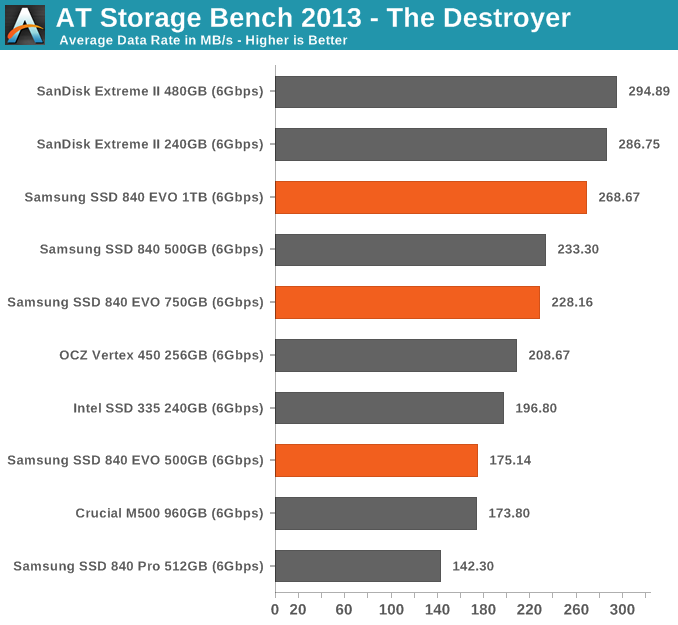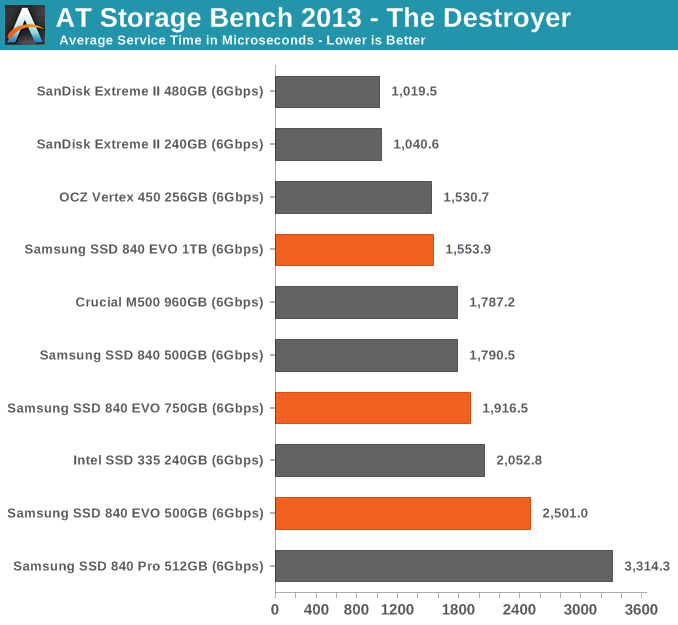Samsung SSD 840 EVO Review: 120GB, 250GB, 500GB, 750GB & 1TB Models Tested
by Anand Lal Shimpi on July 25, 2013 1:53 PM EST- Posted in
- Storage
- SSDs
- Samsung
- TLC
- Samsung SSD 840
AnandTech Storage Bench 2013
When I built the AnandTech Heavy and Light Storage Bench suites in 2011 I did so because we didn't have any good tools at the time that would begin to stress a drive's garbage collection routines. Once all blocks have a sufficient number of used pages, all further writes will inevitably trigger some sort of garbage collection/block recycling algorithm. Our Heavy 2011 test in particular was designed to do just this. By hitting the test SSD with a large enough and write intensive enough workload, we could ensure that some amount of GC would happen.
There were a couple of issues with our 2011 tests that I've been wanting to rectify however. First off, all of our 2011 tests were built using Windows 7 x64 pre-SP1, which meant there were potentially some 4K alignment issues that wouldn't exist had we built the trace on a system with SP1. This didn't really impact most SSDs but it proved to be a problem with some hard drives. Secondly, and more recently, I've shifted focus from simply triggering GC routines to really looking at worst case scenario performance after prolonged random IO. For years I'd felt the negative impacts of inconsistent IO performance with all SSDs, but until the S3700 showed up I didn't think to actually measure and visualize IO consistency. The problem with our IO consistency tests are they are very focused on 4KB random writes at high queue depths and full LBA spans, not exactly a real world client usage model. The aspects of SSD architecture that those tests stress however are very important, and none of our existing tests were doing a good job of quantifying that.
I needed an updated heavy test, one that dealt with an even larger set of data and one that somehow incorporated IO consistency into its metrics. I think I have that test. I've just been calling it The Destroyer (although AnandTech Storage Bench 2013 is likely a better fit for PR reasons).
Everything about this new test is bigger and better. The test platform moves to Windows 8 Pro x64. The workload is far more realistic. Just as before, this is an application trace based test - I record all IO requests made to a test system, then play them back on the drive I'm measuring and run statistical analysis on the drive's responses.
Imitating most modern benchmarks I crafted the Destroyer out of a series of scenarios. For this benchmark I focused heavily on Photo editing, Gaming, Virtualization, General Productivity, Video Playback and Application Development. Rough descriptions of the various scenarios are in the table below:
| AnandTech Storage Bench 2013 Preview - The Destroyer | ||||||||||||
| Workload | Description | Applications Used | ||||||||||
| Photo Sync/Editing | Import images, edit, export | Adobe Photoshop CS6, Adobe Lightroom 4, Dropbox | ||||||||||
| Gaming | Download/install games, play games | Steam, Deus Ex, Skyrim, Starcraft 2, BioShock Infinite | ||||||||||
| Virtualization | Run/manage VM, use general apps inside VM | VirtualBox | ||||||||||
| General Productivity | Browse the web, manage local email, copy files, encrypt/decrypt files, backup system, download content, virus/malware scan | Chrome, IE10, Outlook, Windows 8, AxCrypt, uTorrent, AdAware | ||||||||||
| Video Playback | Copy and watch movies | Windows 8 | ||||||||||
| Application Development | Compile projects, check out code, download code samples | Visual Studio 2012 | ||||||||||
While some tasks remained independent, many were stitched together (e.g. system backups would take place while other scenarios were taking place). The overall stats give some justification to what I've been calling this test internally:
| AnandTech Storage Bench 2013 Preview - The Destroyer, Specs | |||||||||||||
| The Destroyer (2013) | Heavy 2011 | ||||||||||||
| Reads | 38.83 million | 2.17 million | |||||||||||
| Writes | 10.98 million | 1.78 million | |||||||||||
| Total IO Operations | 49.8 million | 3.99 million | |||||||||||
| Total GB Read | 1583.02 GB | 48.63 GB | |||||||||||
| Total GB Written | 875.62 GB | 106.32 GB | |||||||||||
| Average Queue Depth | ~5.5 | ~4.6 | |||||||||||
| Focus | Worst case multitasking, IO consistency | Peak IO, basic GC routines | |||||||||||
SSDs have grown in their performance abilities over the years, so I wanted a new test that could really push high queue depths at times. The average queue depth is still realistic for a client workload, but the Destroyer has some very demanding peaks. When I first introduced the Heavy 2011 test, some drives would take multiple hours to complete it - today most high performance SSDs can finish the test in under 90 minutes. The Destroyer? So far the fastest I've seen it go is 10 hours. Most high performance I've tested seem to need around 12 - 13 hours per run, with mainstream drives taking closer to 24 hours. The read/write balance is also a lot more realistic than in the Heavy 2011 test. Back in 2011 I just needed something that had a ton of writes so I could start separating the good from the bad. Now that the drives have matured, I felt a test that was a bit more balanced would be a better idea.
Despite the balance recalibration, there's just a ton of data moving around in this test. Ultimately the sheer volume of data here and the fact that there's a good amount of random IO courtesy of all of the multitasking (e.g. background VM work, background photo exports/syncs, etc...) makes the Destroyer do a far better job of giving credit for performance consistency than the old Heavy 2011 test. Both tests are valid, they just stress/showcase different things. As the days of begging for better random IO performance and basic GC intelligence are over, I wanted a test that would give me a bit more of what I'm interested in these days. As I mentioned in the S3700 review - having good worst case IO performance and consistency matters just as much to client users as it does to enterprise users.
I'm reporting two primary metrics with the Destroyer: average data rate in MB/s and average service time in microseconds. The former gives you an idea of the throughput of the drive during the time that it was running the Destroyer workload. This can be a very good indication of overall performance. What average data rate doesn't do a good job of is taking into account response time of very bursty (read: high queue depth) IO. By reporting average service time we heavily weigh latency for queued IOs. You'll note that this is a metric I've been reporting in our enterprise benchmarks for a while now. With the client tests maturing, the time was right for a little convergence.

There's simply no comparison between the EVO and Crucial's M500. Even at half the capacity, the EVO does a better job in our consistency test. SanDisk's Extreme II remains the king here but that's more of a performance tuned part vs. something that offers better cost per GB. Note just how impactful the added spare is on giving the EVO an advantage over even the 840 Pro. It's so very important that 840 Pro owners keep as much free space on the drive as possible to keep performance high and consistent.











137 Comments
View All Comments
spazoid - Thursday, July 25, 2013 - link
It's free. Free is better.jhh - Thursday, July 25, 2013 - link
Are there any latency measurements in milliseconds as opposed to IOPS? With IOPS, the drive may be queuing rquests, making it difficult to translate IOPS to milliseconds per request.Kibbles - Thursday, July 25, 2013 - link
If I write 1gb/day on average to my SSD, since media files go on my home server, this drive would last me 395 years LOL!sheh - Thursday, July 25, 2013 - link
Anand, would you consider writing an article on the other aspect of endurance: data retention time? With TLC entering the fray it's starting to get even more worrying.It'd be interesting to know how retention time changes throughout a drive's life, trends in the last few years, differences between manufacturers, the effect of the JEDEC standard, whether there's any idle-time refreshing for old written cells, etc.
And an idea: I'd like to see drives where you can configure whether to use the drive as SLC/MLC/TLC. Switch to SLC for reliability/performance, TLC for capacity.
MrSpadge - Saturday, July 27, 2013 - link
"And an idea: I'd like to see drives where you can configure whether to use the drive as SLC/MLC/TLC. Switch to SLC for reliability/performance, TLC for capacity."Or a drive which switches blocks from TLC operation to MLC as it runs out of writes cycles. And finally to SLC.. at which point in time it should last pretty much infinitely.
mgl888 - Thursday, July 25, 2013 - link
Great article.Does RAPID require that you install a separate driver or does it just work automatically out of the box? What's the support like for Linux?
bobbozzo - Friday, July 26, 2013 - link
It's a driver, for Windows.TheinsanegamerN - Saturday, July 27, 2013 - link
and i dont think that rapid has a reason to be on linux. linux is already much better with ssd writes than windows.chizow - Thursday, July 25, 2013 - link
Minor spelling correction: http://www.anandtech.com/show/7173/samsung-ssd-840..."counterfit" should be "counterfeit"
chizow - Thursday, July 25, 2013 - link
Nice review Anand, I'm really glad to see almost all the top SSDs from numerous makers (Samsung, Crucial, SanDisk, Intel) are creeping up and exceeding SATA2 specs across the board and nearly saturating SATA3 specs.It really is amazing though how Samsung seems to be dominating the SSD landscape. I know this review is a bit skewed though since you presumably tried to include almost all the Samsung capacity offerings (for comparison sake), but the impact of the 840, 840 Pro and now the 840 EVO on the SSD market are undeniable. They really have no weaknesses, other than perhaps the Seq. Write Speeds on the 840/EVO.
I guess this is why there's so many deals currently on the 840, I bought the 250GB version earlier this month and don't really regret it given the price I got it for, but the EVO is certainly a step up in nearly every aspect.